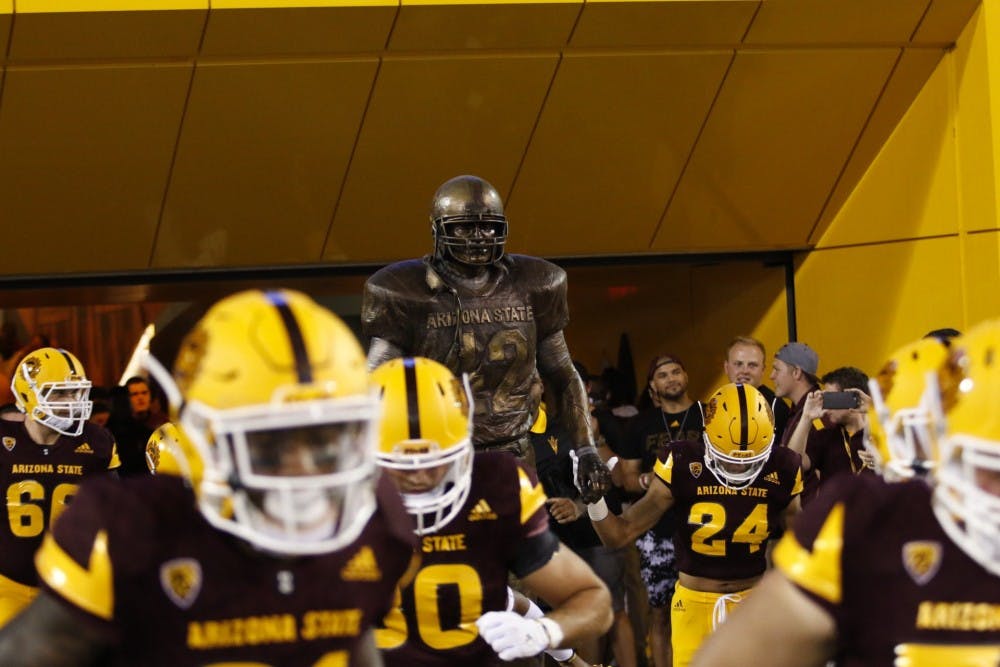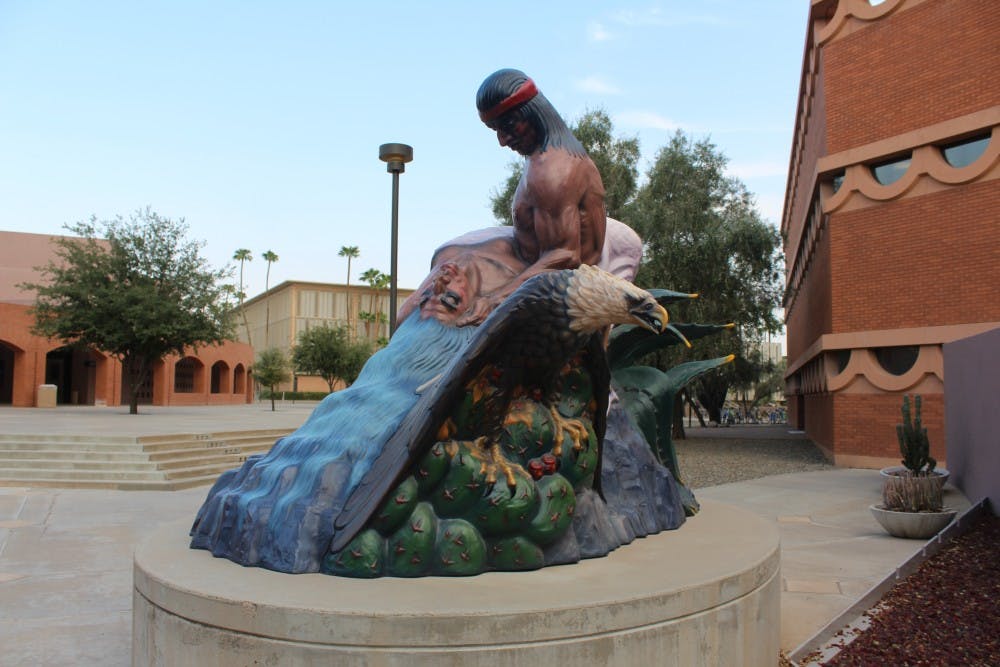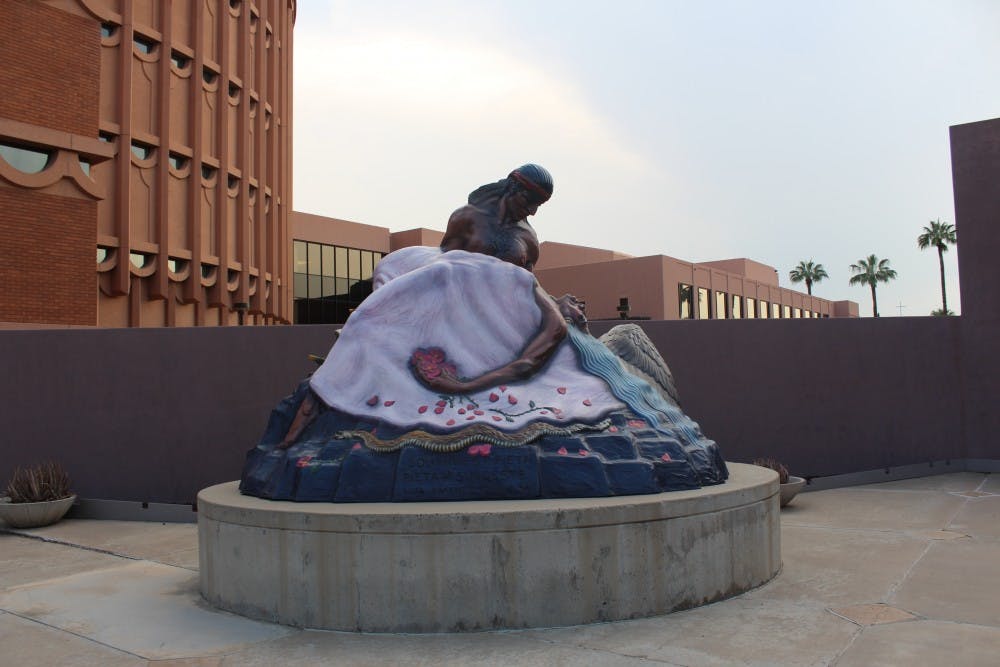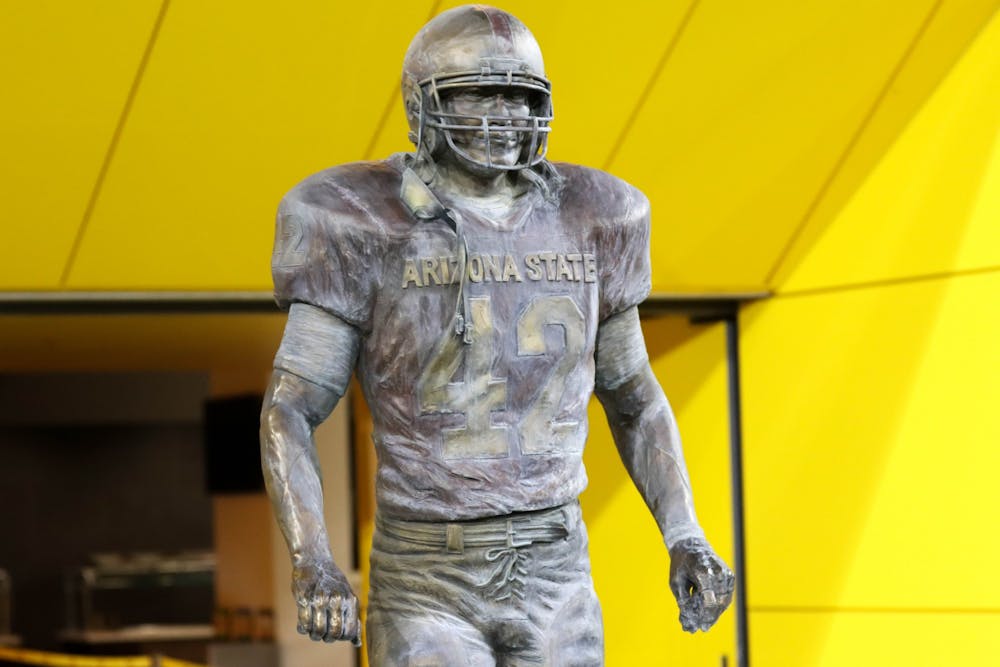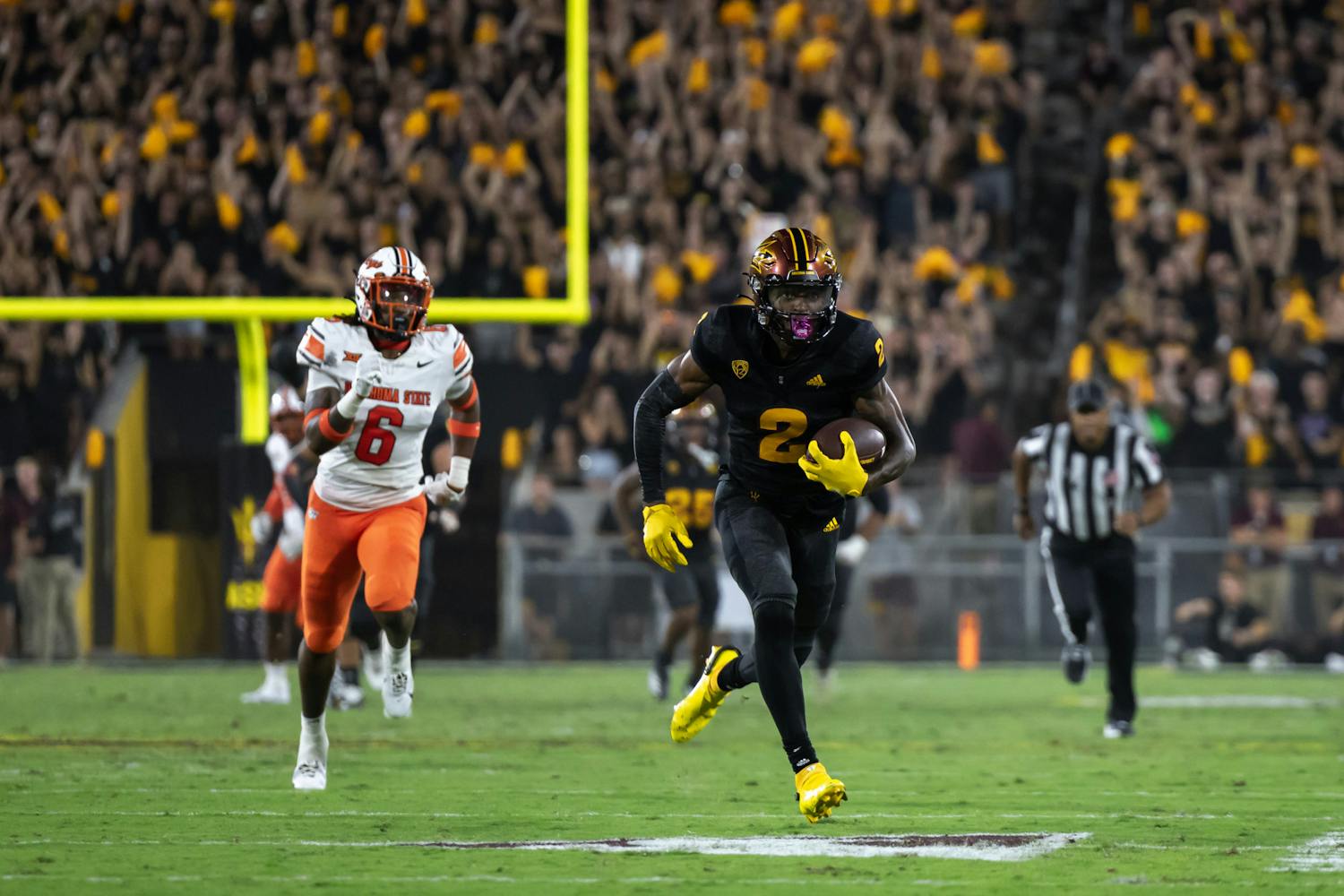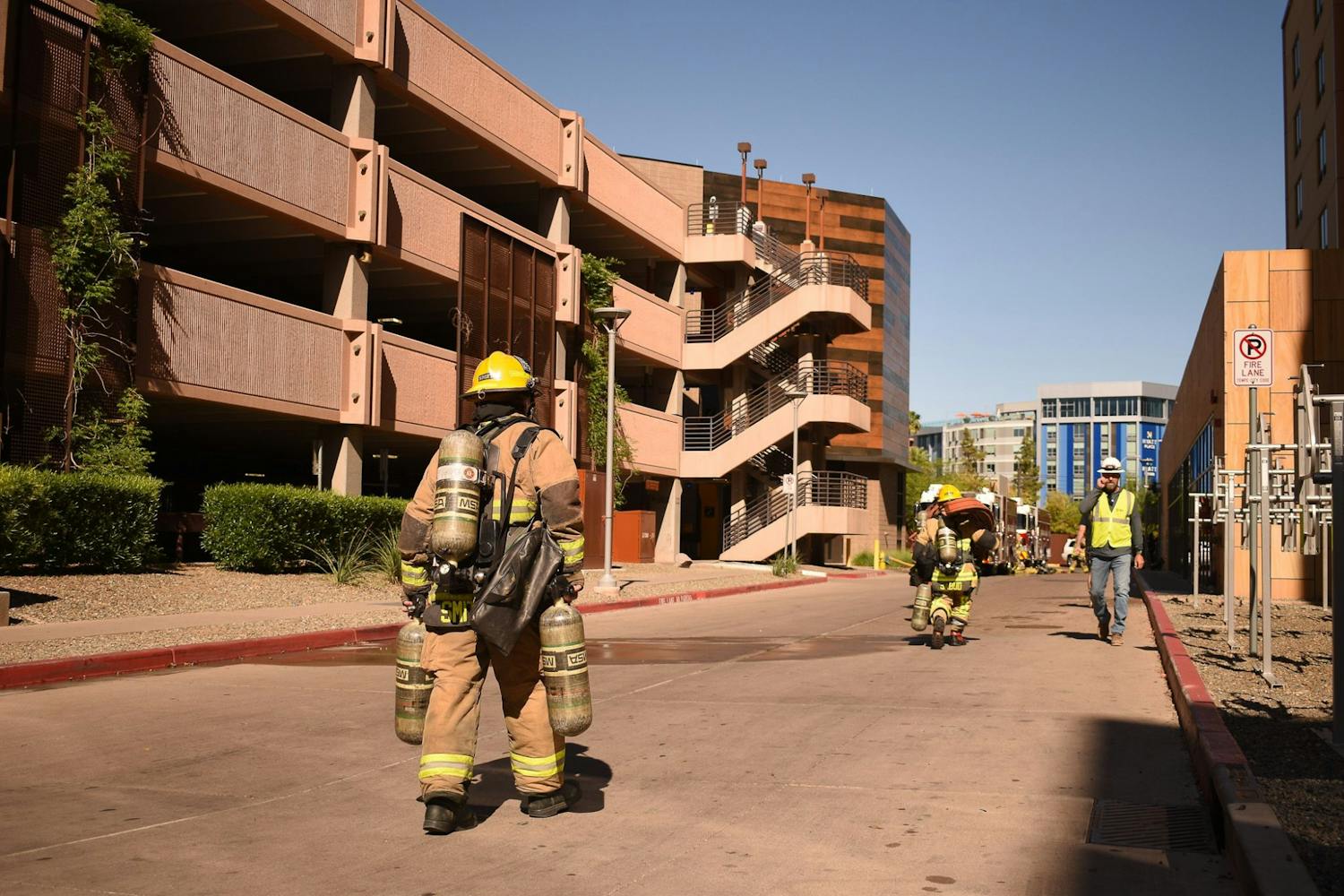Unmoving figures watch as the microcosm that is ASU's Tempe campus moves around them. They're present when the first student heads to the SDFC to get a morning workout, and they're there when the last student hurries to catch the final intercampus shuttle of the day.
But most students barely bat an eye, oftentimes passing by without knowing why they're there.
Statues adorn the ASU campuses, all assuming their various roles while few think twice about what they mean.
Joshua Shelley, a freshman studying business entrepreneurship, was sitting next to the Spirit statue in the W.P. Carey School of Business complex when asked what he thought about it.
"I have several classes here, and I never really stopped [to look at it]," he said.
Breanna Brocker, a junior studying theater design and production, had just left the Nelson Fine Arts Center and passed by the Southwest Pieta statue when asked what she thought about it.
"I did notice it because when I was a freshman, it was all covered up, so as soon as it was uncovered, I was like, 'Oh hey, there's a statue there,'" she said. "I haven't really thought about what it could mean. I just thought it was pretty."
Despite frequenting the area for classes, Brocker said she didn't know when the statue was placed in its current spot — let alone why it was even there.
Douglas Tammaro, senior associate athletic director, helped create the Pat Tillman Foundation and Pat's Run. When asked about the Pat Tillman statue located outside of the players' tunnel in Sun Devil Stadium, he said he wishes more people could see it.
Whether it's five horses trying to invoke the entrepreneurial spirit, a piece about a tragic love story of the Southwest Pieta or a replica of football player Pat Tillman, all these statues hiding in plain sight on campus hold innumerable stories and meanings.
And aside from their individual meanings and aesthetics, all these statues have one thing in common: they all make a political statement.
Politics and history of statues
University archivist Shannon Walker said the statues at ASU are important because they establish the campus as a place in the community.
They add to the aesthetics and the atmosphere of the campus and give you the feeling that "you're here for something bigger than yourself," she said.
However, Walker has been a university archivist for about two-and-a-half years and said she has never had a conversation with someone about what statues mean.
According to Mark Tebeau, an associate professor at ASU's School of Historical, Philosophical and Religious Studies, whenever a statue is placed in a public or private space, it is there to make a point.
"Any statue is an act of propaganda," he said. "It's a production of a myth, we just gotta recognize that."
The myth these statues hope to create — and the ideologies they aim to promote — is most tied to how a statue is funded, Tebeau said; In order to find out what a statue's purpose is, you have to follow the money, he added.
"Who decides (what statues are built), usually and almost exclusively, are those with social and political power in the United States," he said. "The fact that the vast majority, an overwhelming majority, of our monuments celebrate white male military and political leaders is a good representation of the people who commissioned the monuments."
Spirit
The Spirit sculpture was placed in the W.P. Carey School of Business complex in 2009. It was originally located outside of the Fleischer Museum in Scottsdale and depicts five bronze horses rising from the Earth.
"In a representational sculpture, you are expressing one second frozen in time," artist Buck McCain said in a Tempe Public Art brochure. "In a painting, you can suggest linear time and movement, and you can depict the atmosphere around the moving figure with dust around a running horse. You cannot, however, make dust out of bronze, nor can you blur the image, depicting motion. Bronze is an unrelenting metal and to suggest movement you have to resort only to the form."
Businessman Morton Fleischer and his wife, Donna, who was an ASU graduate, donated the statue in hopes it will inspire students about entrepreneurship, philosophy and art.
"SPIRIT symbolizes the power of freedom in America," the plaque in front of the statue reads. "It is the combination of political and economic freedom that creates democratic capitalism which makes up the economic and cultural environment of America."
Karen Stark, manager of W.P. Carey Undergraduate Programs Admissions, said she thinks the donors' intent as well as the artist's intent is to provide students a reminder of "all the things that make America great."
"It's really become a symbol of entrepreneurship and capitalism in America," she said. "The opportunity for students to be reminded about what it means to have a free society."
Joanna Osnaya, a 2022 ASU graduate in marketing, said she often frequents the area and has noticed the statue.
"I have stared at it a couple times before, and every time I've stared at it — it gives me motivation and reminds me of how horses are so noble but fierce," she said. "It makes sense that it's entrepreneurial inspired."
Even though Spirit has political weight, many people on campus just see it for what it is: a group of horses.
Shelley assumed that the plaques near the statue have historical information and meaning, but said he never read them. After glancing at the statue, he said, "it makes me feel like I'm in a rodeo."
However, he admitted that the statue is cool and "provides more detail than just boring buildings."
Tebeau said it is common for people to not notice statues because they become normalized and disappear into the background.
"Most people actually forget what those original stories were, but they still kind of lurk in our consciousness and tell us who we are as a people," he said.
Southwest Pieta
Southwest Pieta — a statue nestled between the ASU Art Museum, the fine arts center and the music building — was completed in 1987 and depicts Popocatépetl, a Mexican warrior, holding his lover, Iztaccíhuatl, the daughter and princess of a tribal chief, as she dies.
The legend behind the statue goes that Iztaccíhuatl's father sent Popocatépetl to war after promising him that he could marry Iztaccíhuatl if he returned. Meanwhile, the chief arranged several suitors for Iztaccíhuatl, assuming Popocatépetl wouldn't return. Refusing to marry anyone else and believing that Popocatépetl wouldn't come back, Iztaccíhuatl killed herself with a dagger.
Popocatépetl returned to his dead lover and took her body to the top of a mountain hoping the cold would wake her up. Instead, he froze, and God changed them into mountains. Iztaccíhuatl's mountain was called La Mujer Dormida as it resembles a sleeping woman. Popocatépetl became a volcano, raging at the loss of lover.
An eagle, a rattlesnake and a cactus — elements found in Native American religions and rituals — are also included in the sculpture. Luis Jimenez, the artist behind Southwest Pieta, was born on July 30, 1940, in El Paso, Texas, and was of Mexican descent. He was known for his large polychrome fiberglass sculptures — which is how he made Southwest Pieta — which depicted a lot of Southwestern and Hispanic themes.
Aside from the story the statue tells, Tebeau connects the piece to historical context that gives it a political meaning. He said the fact the statue was made in the '80s fits into what was going on at ASU at the time: "There was an effort here in the '70s and '80s by Mexican students to get recognition on campus, so if you see something like that in the '80s, I would suspect that's how it would have originated — which also fits with a larger timeline.
"In the '60s, the emergence of the Chicano movement in Los Angeles was an effort made by Mexican Americans to claim political and social power," he said. "So what's going on in the '70s and '80s is surely related to that."
Without knowing the historical context behind Southwest Pieta, Corie Cisco, a project coordinator at the ASU library, said she thinks the statue is important in terms of student representation.
"We have a lot of Latin students, of Hispanic heritage as well, and I think having art that's on campus that is reflective of the student population is important to the ASU community and culture too," she said.
Brocker said having statues like Southwest Pieta on campus is nice because you get to see art as you pass by. However, she added that she doesn't "think of them a lot for their artistic merit."
Pat Tillman
In 2017, the University unveiled a statue of Pat Tillman, an ASU alumni who died in 2004 while fighting in the Afghanistan War.
Tillman was known for being an exemplary student athlete, graduating from the W.P. Carey School of Business with a degree in marketing in 1997 while excelling in football.
In 1998, Tilman was drafted to the NFL, where he played for the Arizona Cardinals. He then enlisted in the army in 2002 after the 9/11 attacks, serving in Iraq and Afghanistan until he died in 2004.
However, the way Tillman died — and the legacy he left behind — raises questions on what the statue truly symbolizes.
"There was a war of choice created on a fabricated lie," Tebeau said. "Pat Tillman himself, would have described — in fact, did describe — the war in Iraq as illegal, so there's a complicated story there."
When Tillman died, it was initially reported that he had been killed by enemy combatants. However, a further investigation discovered that he had been killed due to friendly fire.
"There's no question that his death — there's some mystery, and there's some sadness about friendly fire and cover up," Tammaro said.
Historically, creating a statue with the intention of memorializing an individual military service isn't common. According to Tebeau, the Pat Tillman statue would be an "atypical war monument in the United States in the early 21st century" because war monuments have typically depicted a collective of soldiers.
Tebeau pointed out that the timing of when the statue was created versus when the Pat Tillman Foundation was created is also intriguing to look at: "What's happening here at ASU from 2005 to 2020? ASU goes from the world's greatest party school to the world's most innovative university," he said.
READ MORE: No.1 in innovation: How Crow has kept ASU's eight-year streak going
Because of this change, he said erecting the Pat Tillman statue was a way for the University to show that it is changing its narrative and that "the character of Pat Tillman is the character of our students."
For Tammaro, however, Tillman's legacy alone is the reason why the statue was erected.
"The main reason is there's still the energy because of the foundation, because of the run, because of the outpouring support that the run and the foundation have had," he said. "He passed away in 2004 and his foundation 19 years later is still going strong."
Despite the politics of the war and his views on the school's agenda, Tebeau did note that the statue is of Tillman in an ASU football jersey and not a military uniform.
"To me, it just represents the ultimate example of a great student athlete," Tammaro said. "Before he was USA, he was ASU."
According to Tebeau, it's important to remember that history is a conversation about the past.
"A piece of marble is not history," he said.
Therefore, he encourages passersby to try to put the statues into historical context and understand what they are trying to express.
Walker adds that students should stop, look at the statues, and take them in.
"I know most of you are buried in your phones or are just hustling from class to class and don't take time to think about art, but it's really important. Art is such a big part of being alive."
Edited by Sam Ellefson, Camila Pedrosa and Alexis Moulton.
Reach the reporter at savannah.dagupion@gmail.com and follow @savdagupion on Twitter.
Like State Press Magazine on Facebook and follow @statepressmag on Twitter and Instagram.

Savannah Rose Dagupion is a reporter for State Press Magazine. She moved to Arizona from Hawaiʻi to study Journalism and Mass Communication at the Cronkite School.
